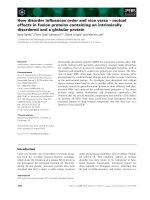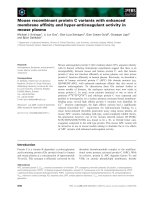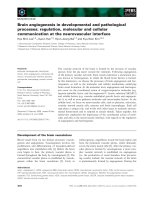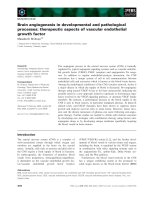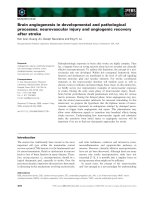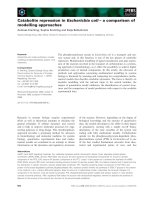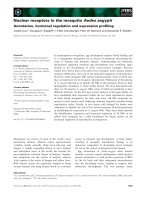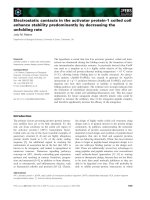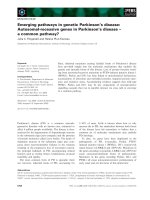Báo cáo khoa học: " Multipathogen infections in hospitalized children with acute respiratory infections" doc
Bạn đang xem bản rút gọn của tài liệu. Xem và tải ngay bản đầy đủ của tài liệu tại đây (426.32 KB, 7 trang )
BioMed Central
Page 1 of 7
(page number not for citation purposes)
Virology Journal
Open Access
Research
Multipathogen infections in hospitalized children with acute
respiratory infections
Dan Peng
1
, Dongchi Zhao*
1
, Jingtao Liu
1
, Xia Wang
1
, Kun Yang
1
,
Hong Xicheng
2
, Yang Li
2
and Fubing Wang
3
Address:
1
Pediatrics Department, Zhongnan Hospital, Wuhan University, Wuhan 430071, PR China,
2
Statistics Department, Public Health
Institute, Wuhan University, Wuhan 430071, PR China and
3
Clinical Investigation Department, Zhongnan Hospital, Wuhan University, Wuhan
430071, PR China
Email: Dan Peng - ; Dongchi Zhao* - ; Jingtao Liu - ;
Xia Wang - ; Kun Yang - ; Hong Xicheng - ; Yang Li - ;
Fubing Wang -
* Corresponding author
Abstract
Background: To explore the epidemiologic and clinical features of, and interactions among,
multipathogen infections in hospitalized children with acute respiratory tract infection (ARTI). A
prospective study of children admitted with ARTI was conducted. Peripheral blood samples were
analyzed by indirect immunofluorescence to detect respiratory agents including respiratory
syncytial virus; adenovirus; influenza virus (Flu) types A and B; parainfluenza virus (PIV) types 1, 2,
and 3; chlamydia pneumonia; and mycoplasma pneumonia. A medical history of each child was
taken.
Results: Respiratory agents were detected in 164 (51.9%) of 316 children with ARTI. A single
agent was identified in 50 (15.8%) children, and multiple agents in 114 (36.1%). Flu A was the most
frequently detected agent, followed by Flu B. Coinfection occurred predominantly in August and
was more frequent in children between 3 and 6 years of age. A significantly higher proportion of
Flu A, Flu B, and PIV 1 was detected in samples with two or more pathogens per sample than in
samples with a single pathogen.
Conclusion: Our study suggests that there is a high occurrence of multipathogen infections in
children admitted with ARTI and that coinfection is associated with certain pathogens.
Introduction
Almost two million children die each year from acute res-
piratory tract infection (ARTI), and most of these children
live in developing countries [1]. In developed countries,
the incidence of lower respiratory tract infection is high
and causes 19% to 27% of hospitalizations in children
under the age of 5 years in the USA [2,3]. The etiologic
agents of these common infections are respiratory syncy-
tial virus (RSV); adenovirus (Adv); influenza virus (Flu)
types A and B; parainfluenza virus (PIV) types 1, 2, and 3;
chlamydia pneumonia (CP); and mycoplasma pneumo-
nia (MP) [4].
The relationship between clinical symptoms and respira-
tory infections has been discussed frequently in the litera-
ture, but viral detection provides more specific
Published: 29 September 2009
Virology Journal 2009, 6:155 doi:10.1186/1743-422X-6-155
Received: 15 July 2009
Accepted: 29 September 2009
This article is available from: />© 2009 Peng et al; licensee BioMed Central Ltd.
This is an Open Access article distributed under the terms of the Creative Commons Attribution License ( />),
which permits unrestricted use, distribution, and reproduction in any medium, provided the original work is properly cited.
Virology Journal 2009, 6:155 />Page 2 of 7
(page number not for citation purposes)
information on the correlation between clinical symp-
toms and specific infections [5-7]. With recent advances in
methods to detect respiratory agents, numerous studies
have shown that some pediatric patients with acute lower
respiratory tract infection become infected simultane-
ously with multiple respiratory viruses [8-10]. However,
despite the high rate of infection with viral and other res-
piratory agents, such as CP and MP, coinfection has
received little attention. The aim of this study was to
explore the epidemiologic and clinical features of, and
interactions among, multipathogen infections in children
hospitalized with ARTI in central China.
Results
Prevalence of respiratory agents
Respiratory agents were detected in 164 (51.9%) of the
316 children with ARTI. Patients with signs of bacterial
infections were excluded from the cohort. A single agent
was identified in 50 (15.8%) children and two or more
agents in 114 (36.1%). The most frequently detected
agent was Flu A (n = 97), followed by Flu B (n = 91), Adv
(n = 77), and MP (n = 53). In the 114 specimens with
multipathogen infections, the most frequent combina-
tions were Flu A plus Flu B, followed by Adv plus Flu A
plus Flu B (Table 1).
Table 1: Associations among nine respiratory pathogens in 316 ARTI children
Pathogens detected Number % of total no. of episodes % of positive episodes
Single infection 50 15.8 30.5
Coinfection, two pathogens 52 16.5 31.7
Flu A + Flu B 34 10.8
Flu-A + Adv 3 0.9
Adv + PIV 3 3 0.9
CP + MP 2 0.6
PIV 1 + PIV 2 2 0.6
MP + Adv 2 0.6
Adv + Flu B/RSV 1/1 0.3/0.3
MP + Flu A/Flu B/RSV/PIV3 1/1/1/1 0.3/0.3/0.3/0.3
Coinfection, three pathogens 37 11.7 22.6
Flu A + Flu B + Adv 20 6.3
Flu A + Flu B + MP 6 1.9
Adv + MP + CP 2 0.6
Flu A + Adv + MP 3 0.9
Flu B + Adv + MP 1 0.3
Flu A + MP + CP 1 0.3
Flu B + PIV 2 + PIV 1 1 0.3
MP + CP + RSV 1 0.3
Flu A + Flu B + PIV 2/PIV 1 1/1 0.3/0.3
Coinfection, four pathogens 14 4.4 8.5
Adv + MP + Flu A + Flu B 5 1.6
Adv + MP + CP + PIV 3 2 0.6
Adv + Flu A + Flu B + PIV 3/RSV 2/1 0.6/0.3
Adv + CP + Flu A + Flu B 1 0.3
Adv + CP + PIV 1 + PIV 2 1 0.3
Adv + MP + PIV 1 + PIV 3 1 0.3
MP + PIV 1 + Flu A + Flu B 1 0.3
Coinfections, five pathogens 9 2.8 5.5
Adv + MP + Flu A + Flu B + PIV 3/PIV 1/CP 2/1/1 0.6/0.3/0.3
Adv + CP + MP + PIV 1 + PIV 2 1 0.3
Adv + PIV 1 + PIV 2 + PIV 3 + Flu B 1 0.3
CP + MP + Flu A + Flu B + PIV 3 1 0.3
Adv + CP + MP + RSV + Flu A/Flu B 1/1 0.3/0.3
Coinfections, six pathogens 2 0.6 1.2
Adv + Flu A + Flu B + PIV 3 + MP + CP 1 0.3
Adv + Flu A + Flu B + PIV 3 + PIV 1 + PIV 2 1 0.3
Total number of coinfections 114 36.1 69.5
Total number of episodes with pathogens detected 164 51.9
No pathogen detected 152 48.1
Total number of episodes 316
Virology Journal 2009, 6:155 />Page 3 of 7
(page number not for citation purposes)
Age and seasonal distributions
The distribution of agents in the different age groups is
presented in Table 2. Flu A infection was detected in 97
patients across all age groups except for the group < 6
months of age. Children between 3 and 6 years of age
were infected most frequently by Flu A (53.3%) and Flu B
(52.0%). Adv and MP were detected in all age groups
although mainly in children between 1 and 6 years of age.
PIV infection occurred in 37 children in all age groups.
More than 50% of the PIV infections in children between
7 months and 3 years of age were type 3. The highest inci-
dence of infection was in children between 3 and 6 years
of age, and one or more agents were detected in 68.0% of
the episodes. Coinfection was more frequent in children
between 3 and 6 years of age (76.5%) than in other age
groups.
The monthly distribution of pathogens is shown in Figure
1. The rate of MP infection increased in the early summer
and peaked in August. The prevalence of Flu A, Flu B, and
Adv peaked in October. CP and PIV 1, 2, and 3 were
detected sporadically in a small number of children dur-
ing the entire study period. Coinfection was more fre-
quent in August (60.0%; 9/15).
Clinical features
The length of hospital stay and other parameters such as
the presence of fever, cough, or vomiting, and white blood
cell count did not differ significantly between uninfected
children, those with a single infection, or coinfected chil-
dren (Table 3).
Relationship between the incidence of pathogens and
multiple infections
Figure 2 shows that the incidence of CP, Adv, and PIV 1,
2, and 3 increased with the number of pathogens per sam-
ple. The incidence of Flu A and B first increased with the
number of pathogens per sample and then decreased
when the number of pathogens per sample was more than
three. Similarly, the incidence of MP increased with the
number of pathogens per sample but decreased when the
number of pathogens per sample was six. There was a sig-
nificantly higher proportion of Flu A (χ
2
= 50.398, p <
0.001), Flu B (χ
2
= 60.259, p < 0.001), and PIV 1 (χ
2
=
5.171, p < 0.05) in samples with two or more pathogens
than in those with a single pathogen.
Binary logistic regression analysis
In the simple logistic regression analysis, infection with
Flu B (odds ratio [OR] = 109.71, p < 0.05) or Adv (OR =
3.99, p < 0.05) was an independent factor associated with
the incidence of Flu A. In the multivariate logistic regres-
sion analysis, only Flu B (OR = 97.22, p < 0.05) was an
independent factor (Table 4). In the simple logistic regres-
sion analysis, infection with Flu A (OR = 88.98, p < 0.05),
Adv (OR = 3.69, p < 0.05), or MP (OR = 1.99, p < 0.05)
was an independent factor associated with the incidence
of Flu B. In the multivariate logistic regression analysis,
only Flu A (OR = 79.504, p < 0.05) was an independent
factor. In the simple logistic regression analysis of Adv
infection, infection with Flu B (OR = 3.69, p < 0.05), Flu
A (OR = 3.72, p < 0.05), CP (OR = 2.97, p < 0.05), MP (OR
= 6.47, p < 0.05), PIV 1 (OR = 3.96, p < 0.05), or PIV3 (OR
= 11.93, p < 0.05) was an independent factor associated
with the incidence of Adv. In the multivariate logistic
regression analysis, infection with Flu A (OR = 2.53, p <
Table 2: The distribution of agents according to age group
Agent
Group
1-6 mo; n = 41 7 mo-1 yr; n = 53 1-3 yr; n = 105 3-6 yr; n = 75 > 6 yr; n = 42 Total; n = 316
Total
no.
(%)
a
Coinfec
tion
no. (%)
b
Total
no.
(%)
a
Coinfec
tion
no. (%)
b
Total
no.
(%)
a
Coinfec
tion
no. (%)
b
Total
no.
(%)
a
Coinfec
tion
no. (%)
b
Total
no.
(%)
a
Coinfec
tion
no. (%)
b
Total
no.
(%)
a
Coinfec
tion
no. (%)
b
RSV 1 (2.4) 1 (100) 3 (5.7) 3 (100) 1 (1.0) 1 (100) 1 (1.3) 1 (100) 0 (-) 0 (-) 6 (1.9) 6 (100)
Adv 10 (24.4) 5 (50) 11 (20.8) 6 (54.5) 28 (26.7) 21 (75.0) 20 (26.7) 18 (90.0) 7 (16.7) 7 (100) 77 (24.4) 58 (75.3)
CP 3 (7.3) 3 (100) 6 (11.3) 6 (100) 4 (3.8) 3 (75.0) 1 (1.3) 1 (100) 3 (7.1) 3 (100) 17 (5.4) 16 (94.1)
MP 6 (14.6) 4 (66.7) 9 (17.0) 8 (88.9) 21 (20.0) 15 (71.4) 12 (16.0) 9 (75.0) 5 (11.9) 4 (80.0) 53 (16.8) 40 (75.5)
Flu A 0 (-) 0 (-) 6 (11.3) 6 (100) 39 (37.1) 36 (92.3) 40 (53.3) 35 (87.5) 12 (28.6) 11 (91.7) 97 (30.7) 88 (90.7)
Flu B 0 (-) 0 (-) 6 (11.3) 6 (100) 33 (31.4) 32 (100) 39 (52.0) 37 (94.8) 13 (31.0) 11 (84.6) 91 (28.8) 86 (94.5)
PIV 1 0 (-) 0 (-) 3 (5.7) 3 (100) 2 (1.9) 2 (97.0) 4 (5.3) 4 (100) 2 (4.8) 2 (100) 11 (3.5) 11 (100)
PIV 2 0 (-) 0 (-) 2 (3.8) 2 (100) 1 (1.0) 1 (100) 3 (4.0) 3 (100) 3 (7.1) 2 (66.7) 9 (2.8) 8 (88.9)
PIV 3 2 (4.9) 2 (100) 5 (9.4) 3 (60) 5 (4.8) 5 (100) 2 (2.7) 2 (100) 3 (7.1) 3 (100) 17 (5.4) 15 (88.2)
Episodes 13 (31.7) 6 (46.1) 22 (41.5) 14 (63.6) 59 (56.2) 31 (52.5) 51 (68.0) 39 (76.5) 19 (45.2) 14 (73.7) 164
(51.9)
114
(69.5)
Note. The age is given at the top of each column.
a
Percentage of the total number of episodes investigated in the corresponding age group.
b
Percentage of the total number of infections caused by this pathogen in the corresponding age group.
Virology Journal 2009, 6:155 />Page 4 of 7
(page number not for citation purposes)
0.05), CP (OR = 4.63, p < 0.05), or PIV3 (OR = 11.93, p <
0.05) was an independent factor.
For MP, infection with Flu B (OR = 1.995, p < 0.05), Flu A
(OR = 2.154, p < 0.05), Adv (OR = 2.967, p < 0.05), CP
(OR = 31.111, p < 0.05), or PIV3 (OR = 5.017, p < 0.05)
was an independent factor associated with the incidence
of MP in the simple logistic regression analysis. In the
multivariate logistic regression analysis, only CP (OR =
26.895, p < 0.05) was an independent factor. For CP,
infection with PIV 2 (OR = 5.562, p < 0.05), Adv (OR =
6.472, p < 0.05), MP (OR = 31.111, p < 0.05), or PIV3 (OR
= 6.769, p < 0.05) was an independent factor associated
with the incidence of CP in the simple logistic regression
analysis. In the multivariate logistic regression analysis,
infection with MP (OR = 41.016, p < 0.05) or PIV 2 (OR
= 18.118, p < 0.05) was an independent factor.
For PIV 1, infection with PIV 2 (OR = 265.125, p < 0.05),
Adv (OR = 3.955, p < 0.05), or PIV3 (OR = 7.795, p <
0.05) was an independent factor associated with the inci-
dence of PIV 1 in the simple logistic regression analysis. In
the multivariate logistic regression analysis, only PIV 2
(OR = 292.808, p < 0.05) was an independent factor. For
PIV 2, infection with PIV 1 (OR = 265.125, p < 0.05), CP
(OR = 5.562, p < 0.05), or PIV3 (OR = 5.562, p < 0.05)
Monthly distribution of the total percentage of patientsFigure 1
Monthly distribution of the total percentage of patients. Adv, adenovirus; Flu, influenza virus; PIV, parainfluenza virus;
CP, chlamydia pneumonia; MP, mycoplasma pneumonia.
Table 3: Clinical presentations in 316 hospitalized ARTI children
Patient characteristic Negative
a
n = 152
Single infection
a
n = 50
Coinfection
a
n = 114
Length of hospital stay (d) 8.44 ± 3.99 7.62 ± 2.91 7.74 ± 2.75
Fever
b
90 30 83
Vomiting 35 12 25
Cough 113 36 75
Rash 11 2 7
Diarrhea 15 2 5
White blood cells/mm
3
< 4000 12 3 12
4000-10000 87 22 62
> 10000 53 24 36
AURI 47 17 40
ALRI 105 33 74
AURI, acute upper respiratory infection; ALRI, acute lower respiratory infection;
a
The number in the corresponding group;
b
Armpit skin
temperature ≥ 37.5°C.
Virology Journal 2009, 6:155 />Page 5 of 7
(page number not for citation purposes)
was an independent factor associated with the incidence
of PIV 2 in the simple logistic regression analysis. In the
multivariate logistic regression analysis, only PIV 1 (OR =
240.106, p < 0.05) was an independent factor. For PIV3,
infection with PIV 1 (OR = 7.795, p < 0.05), CP (OR =
6.769, p < 0.05), MP (OR = 5.017, p < 0.05), or PIV 2 (OR
= 5.562, p < 0.05) was an independent factor associated
with the incidence of PIV3 in the simple logistic regression
analysis. In the multivariate logistic regression analysis,
only Adv (OR = 9.246, p < 0.05) was an independent fac-
tor.
Discussion
We detected more than one agent in 51.9% of children
with a clinical diagnosis of acute respiratory infection. The
most frequent combination was coinfection with two
agents, primarily Flu A plus Flu B. Six episodes involved
coinfection with five agents and two episodes involved
coinfection with six agents.
The prevalence of coinfection in previous studies is 11-
27% in young children with diverse types of respiratory
tract infections seen in the hospital or emergency depart-
ment [8,11-16], and the most frequent combination was
coinfection with two different pathogens. In contrast, we
found a much higher incidence of coinfection with more
than two agents than that reported previously. The differ-
ences in the incidence of coinfection may reflect geo-
graphic differences or differences in etiologic agents
[17,18] or diagnostic methods [19].
The nine pathogens detected in our study are active in
cold and dry environments. It is possible that these agents
are associated because they circulate most frequently at
Correlations between the number of pathogens per sample and the percentage of pathogensFigure 2
Correlations between the number of pathogens per sample and the percentage of pathogens. Adv, adenovirus;
Flu, influenza virus; PIV, parainfluenza virus; CP, chlamydia pneumonia; MP, mycoplasma pneumonia.
Table 4: Cross-correlations of pathogen prevalence rates
Pathogen-positive
Background
Prevalence (%) of pathogens
Adv CP MP Flu A Flu B PIV 1 PIV 2 PIV 3
Adv (77*) 14.3 29.9 53.2 50.6 7.8 5.2 16.9
CP (17*) 64.7 82.4 35.3 29.4 11.8 11.8 23.5
MP (53*) 43.4 26.4 45.3 41.5 7.5 1.9 15.1
Flu A (97*) 42.3 6.2 24.7 82.5 4.1 2.1 7.2
Flu B (91*) 42.9 5.5 24.2 87.9 6.6 4.4 8.8
PIV 1 (11*) 54.5 18.2 36.4 36.4 54.5 63.6 27.3
PIV 2 (9*) 44.4 22.2 11.1 22.2 44.4 77.8 22.2
PIV 3 (17*) 76.5 23.5 47.1 41.2 47.1 17.6 11.8
Note. The bold numbers indicate the most cross-correlation of pathogens coinfection. * Number of samples comprising the background-positive
group.
Virology Journal 2009, 6:155 />Page 6 of 7
(page number not for citation purposes)
the same time of year [15]. In our children, coinfection
was observed most frequently between 3 and 6 years of
age, probably because of the greater incidence of infection
with respiratory pathogens as a whole in this age group
[15].
The IIF method to detect antibody to respiratory patho-
gens may be another reason for the higher rate of coinfec-
tion in our study. IIF is a qualitative test to detect antibody
that yields initial information about the immune status of
the patient, the clinical course of the disease. The presence
of antibodies of class IgM does not show whether the
child is infected with multiple pathogens at the same
time. In most studies, more than 70% of children with an
ARTI have detectable levels of IgM antibodies within one
week after the onset of infection, and the IgM level
declines gradually and becomes undetectable 3 months
after the onset of infection. Thus, the IIF method to detect
antibodies shows only that a child was infected with a res-
piratory pathogen more than one week but less than 3
months before the sample was obtained.
In most published studies of dual respiratory viral infec-
tions (DRVI), more than one viral diagnostic technique
was used to identify respiratory viruses. The rate of DRVI
depends on the number of viral diagnostic methods used.
When only one diagnostic method was used, the overall
rate of DRVI was 1.8%, whereas when two virus detection
methods were used, the rate of DRVI was 9.9%, and when
three methods were used, the rate was 8.4% [20].
Brunstein et al [21] showed that a direct fluorescence
assay backed with a multiplex molecular method is the
current best practice in respiratory diagnostics.
The notable findings in our study were the relationship
between the incidence of pathogens and multiple infec-
tions, and we definitively ruled out preferential interac-
tions among specific agents. A recent study provided
statistical evidence that coinfection is not random and
that coinfection with certain pathogens occurs more fre-
quently than expected if coinfection was random [21].
Some authors have noted no clinical differences between
patients with respiratory infections caused by a single
agent or by multiple agents, in hospitalized patients [22]
and ambulatory children [23]. In particular, Paranhos-
Baccala et al [24] found a significant correlation between
DRVI and increased disease severity of bronchiolitis and
that dual infection was a risk factor for admission to the
pediatric intensive care unit (PICU), independent of the
host's condition. However, we found no significant differ-
ence in clinical parameters associated with infection by a
single pathogen or by multiple agents. All of the five chil-
dren with CMV infection were coinfected, and most had
more than three detectable specific antibodies (IgM) at
the same time.
The limitations of our study include the retrospective
design and the lack of the use of molecular techniques to
detect the respiratory pathogens. Despite these limita-
tions, we identified antibodies to one or more agents in
51.9% of samples.
RSV was detected in only six specimens in this study. RSV
is the most common cause of bronchiolitis and pneumo-
nia in infants and young children [25]. A lower percentage
of infant enrolment might help explain this finding. We
cannot exclude the possibility that the IIF method was not
sensitive enough to detect RSV.
In conclusion, we found frequent multipathogen infec-
tions in children admitted with ARTIs and a significant
relationship between the incidence of pathogens and
multiple infection. Further studies are needed to clarify
the pathogenesis and interactions involved in coinfection
by viruses.
Materials and methods
Patients
A total of 316 pediatric patients (≤ 14 years of age) who
were hospitalized for respiratory tract infection during the
study period May 2008 to April 2009 were investigated in
the pediatric department of Zhongnan Hospital of Wuhan
University, Hubei province in central China. The respira-
tory tract infections were classified as upper or lower res-
piratory tract infection. The symptoms of upper
respiratory tract infection (URTI) included cough, sore
throat, tonsillitis, pharyngitis, and herpangina. Lower res-
piratory tract infections (LRTI) included pneumonia,
bronchitis, bronchiolitis, and asthma [5]. Infected
patients with one or more of these syndromes were
included in this study. Children with presumed nosoco-
mial infections (hospital discharge in the previous 2
weeks or onset of respiratory tract infection more than 48
h after admission) were excluded from this cohort. In the
same patient, only new episodes occurring at an interval
of at least 2 months were included.
A standard medical history was taken from each child and
included epidemiological data, clinical antecedents, cur-
rent disease, clinical manifestations, length of hospital
stay, white blood cell count, and chest X-rays taken else-
where.
Samples and laboratory methods
A peripheral blood sample was obtained from all children
with an ARTI within the first 24 h of admission to the
pediatric department. Specific antibodies (IgM) to the
infectious agents (RSV; Adv; Flu A and B; PIV 1, 2, and 3;
Virology Journal 2009, 6:155 />Page 7 of 7
(page number not for citation purposes)
CP; and MP) were detected using a commercial indirect
immunofluorescence (IIF) kit (EUROIMMUN, Lübeck,
Germany) following the manufacturer's instructions.
Statistical analysis
General data are presented as the percentage or mean ±
SD. All statistical analyses were performed using SPSS
software (version 13; Chicago, IL, USA). The chi-square
test was used to compare between-group differences in
percentages. Binary logistic regression was used to address
the factors that might influence the incidence of the path-
ogens. A p-value < 0.05 was considered significant.
Abbreviations
IIF: indirect immunofluorescence test; ARTI: acute respira-
tory tract infection; RSV: respiratory syncytial virus; Adv:
adenovirus; Flu: influenza virus; PIV: parainfluenza virus;
CP: chlamydia pneumonia; MP: mycoplasma pneumo-
nia.
Competing interests
The authors declare that they have no competing interests.
Authors' contributions
PD wrote the manuscript and collected the data; ZD wrote
the manuscript and analyzed the data; LJ, WX, YK dis-
cussed and reviewed the manuscript; HX and LY provided
statistical analysis; and WF detected the blood samples.
All authors read and approved the final manuscript.
Acknowledgements
This work was supported by the Chinese National Natural Science Foun-
dation (No, 30371501).
References
1. Williams BG, Gouws E, Boschi-Pinto C, Bryce J, Dye C: Estimates
of world-wide distribution of child deaths from acute respi-
ratory infections. Lancet Infect Dis 2002, 2:25-32.
2. Henrickson KJ, Hoover S, Kehl KS, Hua W: National disease bur-
den of respiratory viruses detected in children by polymer-
ase chain reaction. Pediatr Infect Dis J 2004, 23:11-18.
3. Peck AJ, Holman RC, Curns AT, Lingappa JR, Cheek JE, Singleton RJ,
Carver K, Anderson LJ: Lower respiratory tract infections
among American Indian and Alaska native children and the
general population of U.S. children. Pediatr Infect Dis J 2005,
24:342-351.
4. Mclntosh K: Current concepts community-acquired pneu-
monia in children. N Engl J Med 2002, 346:429-437.
5. Tsai HP, Kuo PH, Liu CC, Wang JR: Respiratory viral infections
among pediatric inpatients and outpatients in Taiwan from
1997 to 1999. J Clin Microbiol 2001, 39:111-118.
6. Canducci F, Debiaggi M, Sampaolo M, Marinozzi MC, Berre S, Terulla
C, Gargantini G, Cambieri P, Romero E, Clementi M: Two-year pro-
spective study of single infections and co-infections by respi-
ratory syncytial virus and viruses identified recently in
infants with acute respiratory disease. J Med Virol 2008,
80:716-723.
7. Lin TY, Huang YC, Ning HC, Tsao KC: Surveillance of respiratory
viral infections among pediatric outpatients in northern Tai-
wan. J Clin Virol 2004, 30:81-85.
8. Calvo C, Garcia-Garcia ML, Blanco C, Vazquez MC, Frias ME, Perez-
Brena P, Casas I: Multiple simultaneous viral infections in
infants with acute respiratory tract infections in Spain. J Clin
Virol 2008, 42:268-272.
9. Paranhos-Baccala G, Komurian-Pradel F, Richard N, Vernet G, Lina B,
Floret D: Mixed respiratory virus infections. J Clini Virol 2008,
43:407-410.
10. Fabbiani M, Terrosi C, Martorelli B, Valentini M, Bernini L, Cellesi C,
Cusi M: Epidemiological and clinical study of viral respiratory
tract infections in children from Italy. J Med Virol 2009,
81:
750-756.
11. Aberle JH, Aberle SW, Pracher E, Hutter HP, Kundi M, Popow-
Kraupp T: Single versus dual respiratory virus infections in
hospitalized infants: Impact on clinical course of disease and
interferon-γ response. Pediatr Infect Dis J 2005, 24:605-610.
12. Jennings LC, Anderson TP, Werno AM, Beynon KA, Murdoch DR:
Viral etiology of acute respiratory tract infections in children
presenting to hospital Role of polymerase chain reaction
and demonstration of multiple infections. Pediatr Infect Dis J
2004, 23:1003-1007.
13. Weigl JAI, Puppe W, Grondahl B, Schmitt HJ: Epidemiological
investigation of nine respiratory pathogens in hospitalized
children in Germany using multiplex reverse-transcriptase
polymerase chain reaction. Euro J Clin Microbiol Infect Dis 2000,
19:336-343.
14. Stempel HE, Martin ET, Kuypers J, Englund JA, Zerr DM: Multiple
viral respiratory pathogens in children with bronchiolitis.
Acta Paediatr 2009, 98:123-126.
15. Cilla G, Onate E, Perez-Yarza EG, Montes M, Vicente D, Perez-Tral-
lero E: Viruses in community-acquired pneumonia in children
aged less than 3 years old: High rate of viral coinfection. J
Med Virol 2008, 80:1843-1849.
16. Falchi A, Arena C, Andreoletti L, Jacques J, Leveque N, Blanchon T,
Lina B, Turbelin C, Dorléans Y, Flahault A, Amoros JP, Spadoni G,
Agostini F, Varesi L: Dual infections by influenza A/H3N2 and B
viruses and by influenza A/H3N2 and A/H1N1 viruses during
winter Corsica Island, France. J Clin Virol 2007, 41:148-151.
17. Williams JV, Harris PA, Tollefson SJ, Halburnt-Rush LL, Pingsterhaus
JM, Edwards KM, Wright PF, Crowe JE: Human metapneumovi-
rus and lower respiratory tract disease in otherwise healthy
infants and children. N Engl J Med 2004, 350:443-450.
18. Choi EH, Lee HJ, Kim SJ, Eun BW, Kim NH, Lee JA, Lee JH, Song EK,
Kim SH, Park JY, Sung JY: The association of newly identified
respiratory viruses with lower respiratory tract infections in
Korean children, 2000-2005. Clin Infect Dis 2006, 43:585-592.
19. Kuypers J, Wright N, Ferrenberg J, Huang ML, Cent A, Corey L, Mor-
row R: Comparison of real-time PCR assays with fluorescent-
antibody assays for diagnosis of respiratory virus infections in
children. J Clin Microbiol 2006, 44:2382-2388.
20. Drews AL, Atmar RL, Glezen WP, Baxter BD, Piedra PA, Greenberg
SB: Dual respiratory virus infections. Clin Infect Dis 1997,
25:1421-1429.
21. Brunstein JD, Cline CL, McKinney S, Thomas E: Evidence from
multiplex molecular assays for complex multipathogen
interactions in acute respiratory infections. J Clin Microbiol
2008, 46:97-102.
22. Huang JJ, Huang TY, Huang MY, Chen BH, Lin KH, Jeng JE, Wu JR, Dai
ZK: Simultaneous multiple viral infections in childhood acute
lower respiratory tract infections in southern Taiwan. J Trop
Pediatr 1998, 44:308-311.
23. Legg JP, Warner JA, Johnston SL, Warner JO: Frequency of detec-
tion of picornaviruses and seven other respiratory pathogens
in infants. Pediatr Infect Dis J 2005, 24:611-616.
24. Paranhos-Baccala G, Komurian-Pradel F, Richard N, Vernet G, Lina B,
Floret D: Mixed respiratory virus infections. J Clini Virol 2008,
43:407-410.
25. Hemming VG: Viral respiratory diseases in children: classifica-
tion, etiology, epidemiology, and risk factors. J Pediatr 1994,
124:513-516.

